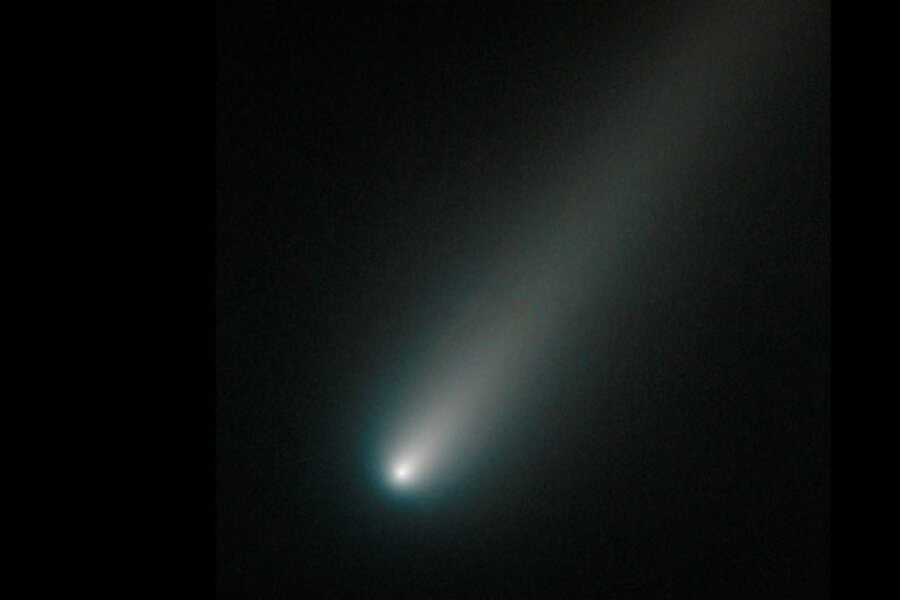Comet with two tails? Comet ISON could provide fascinating spectacle.
Loading...
Comet ISON is boldly taking Earthlings to a region of the sun that no Earthlings or spacecraft bearing them could survive – deep into the sun's fiercely hot outer atmosphere, or corona.
There, the interaction of the comet's gaseous halo and tail with the solar wind and the sun's bubbling magnetic fields is expected to provide clues to one of the sun's great mysteries: Why is the corona so hot, 1 million degrees Fahrenheit or more, when the sun's surface is so much cooler, between 7,000 and 10,000 degrees F.?
“The fact that the corona is hot is why we have the solar wind,” says Dean Pesnell, project scientist for NASA's Solar Dynamics Observatory, a spacecraft launched in February 2010 to study the sun in unprecedented detail.
He's referring to a persistent flow of charged particles and their associated magnetic fields that travel to the very edge of the solar system.
On Earth, these particles generate aurora, especially during periodic solar storms. During some of these outbursts, a relatively small region of the sun can erupt, sending billions of tons of matter hurling through space at speeds of up to 7 million miles an hour. These strongest outbursts, known as coronal-mass ejections, can disrupt communications on Earth, damage satellites, and trigger surges in electrical currents along the power grid that can cause blackouts.
On Mars, billions of years of solar-wind activity are thought to have stripped the planet of most of its atmosphere, turning it from a potentially habitable planet early in its history to the cold, barren planet it is today.
Yet, the solar observatories in space can only see the corona as a whole, and then only when the sun's disc is blocked. They can't bore into its depths to explore specific regions near the interface between the corona and the enormous loops of magnetic fields that sprout from the surface and are thought to energize the corona. The deep corona is where the solar wind is thought to originate.
In Comet ISON, formally known as C/2012 S1, researchers have a natural spacecraft whose emissions of gas can help reveal features deep in the corona that could help solve the why-so-hot problem.
As comets approach the sun, they heat up. Ices in turn directly into gas and erupt from the comet's nucleus, giving a comet the potential for two tails. The first would be made of bright reflective dust ejected by the eruptions and carried away by the pressure of sunlight. The second would come from the electrically charged, or ionized, gases coming off the nucleus and carried away by the solar wind and its magnetic fields.
The interaction of the ionized gas with magnetic fields makes the comets potentially useful probes of the corona, says Joe Gurman, a researcher at the Solar Analysis Data Center at NASA's Goddard Space Flight Center in Greenbelt, Md.
The use of comets as probes of the sun's corona is only two years old. In 2011, two sun-grazing comets, C/2011 N3 and C/2011 W3 (Lovejoy), made close solar approaches. C/2011 N3 vanished after coming within 62,000 miles of the sun's surface. Lovejoy zipped past the sun within about 50,000 miles of the surface then broke apart on the outbound leg of its orbit.
Traveling through the corona, the ionized tails of both comets wiggled and wagged under the influence of variations in the magnetic fields they encountered. When a coronal-mass ejection hit Lovejoy, the blast temporarily sheared off its tail. In addition, researchers were able to watch as ionized gas from Lovejoy began to travel along otherwise invisible magnetic field lines in the corona.
Thus, ISON's ionized gas is expected to provide a fresh picture of the corona's magnetic fields.
Another observation solar physicists would like to make, if they can pull it off, is to track ions from ISON as the solar wind carries them into interplanetary space.
This would allow scientists “to learn how the solar wind is being driven off the sun,” Dr. Pesnell says.
The key: Follow the oxygen ions, he says. When oxygen and other material come off the comet, they are close to room temperature, despite the proximity to the sun. They become ionized, but not as severely – meaning they haven't lost as many electrons – as the more highly ionized oxygen present in the corona.
If those cooler ions get grabbed by the solar wind and carried to sensors currently on orbit, Pesnell says, the measurements can help evaluate models of how the solar wind is generated, in hopes of homing in on the correct explanation.
Researchers weren't able to make this measurement on the two earlier comets. The comets passed too close to the sun. Intense radiation ionized the comet's oxygen to levels that matched the surrounding oxygen so quickly that sensors on space-based solar observatories were unable to tell the difference.
With ISON, the hope is that oxygen ions from the comet hang on to enough of their electrons that space-based observatories will be able to spot them as distinct amid the solar wind.
The approach is a something of a proof-of-concept effort, Pesnell acknowledges.
“We'll have to see how this works," Pesnell says. “We have instruments that are supposed to look at the sun, and now we're trying to make them look at comets. We're hoping that Comet ISON will tell us more about what we can learn from these observations.”
But, he adds, you couldn't ask for a cheaper source of “tracers” for a vital region of the sun that, until now, has defied observation.






